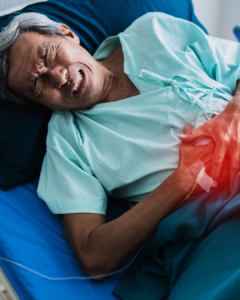Car Accident Internal Bleeding: Causes, Symptoms, And Treatment
Car accidents can cause severe injuries that aren’t always visible immediately. One of the most dangerous hidden injuries is internal bleeding. Unlike external wounds, internal bleeding occurs inside the body and may take hours or even days to show symptoms. Left untreated, it can quickly become life-threatening.
At Specialty Care Clinics, we specialize in identifying and treating internal injuries caused by auto accidents. Understanding the risks, symptoms, and treatment options for internal bleeding could save your life or the life of a loved one after a collision.

What Is Internal Bleeding?
Internal bleeding happens when blood vessels are damaged inside the body, leading to bleeding within organs, tissues, or body cavities. Even a minor car accident can cause enough trauma to rupture blood vessels.
The danger lies in the fact that internal bleeding is often invisible. Many accident victims walk away from a crash feeling “fine,” only to later experience dizziness, pain, or collapse from undetected blood loss.
Common Causes Of Internal Bleeding In Car Accidents
- Blunt Force Trauma – A sudden impact with the steering wheel, dashboard, or seatbelt can damage internal organs.
- Fractures – Broken bones, especially in the ribs, pelvis, or femur, can puncture blood vessels and cause bleeding
- Organ Damage – Trauma to organs like the liver, spleen, or kidneys may lead to slow or massive internal bleeding.
- Head Injuries – Brain bleeds (intracranial hemorrhage) are extremely dangerous and require immediate medical attention.
- Whiplash And Chest Compression – Rapid deceleration or chest impact can tear blood vessels in the chest or abdomen.
Warning Signs Of Internal Bleeding After An Auto Accident
Internal bleeding doesn’t always show obvious symptoms right away. However, some warning signs include:
- Severe or persistent abdominal pain or swelling
- Dizziness, lightheadedness, or fainting
- Cold, clammy skin (a sign of shock)
- Shortness of breath or chest pain
- Blood in urine, stool, or vomit
- Severe bruising around the abdomen, chest, or thighs
- Vision problems, slurred speech, or confusion (possible brain bleed)
If you notice any of these symptoms after a car accident, seek emergency medical care immediately.
Diagnosis Of Internal Bleeding
At Specialty Care Clinics, we use advanced diagnostic tools to quickly identify hidden injuries:
- CT Scans & MRI – Detect bleeding inside the brain, chest, and abdomen.
- Ultrasound – A non-invasive way to identify internal fluid buildup.
- Blood Tests – Check for blood loss and organ function.
- Physical Examination – Evaluate tenderness, swelling, and shock symptoms.
Treatment Options For Internal Bleeding
The treatment depends on the location and severity of the bleed:
- Emergency Surgery – To stop internal bleeding and repair damaged organs.
- Minimally Invasive Procedures – Such as laparoscopy or embolization to seal damaged blood vessels.
- Medications & Fluids – To stabilize blood pressure and manage symptoms.
- Blood Transfusions – Replace lost blood and prevent shock.
- Ongoing Monitoring & Rehabilitation – Ensuring full recovery with long-term care.
Our auto injury clinics in Texas provide customized treatment plans to help patients recover from hidden internal injuries.
Long-Term Risks Of Untreated Internal Bleeding
Delaying treatment for internal bleeding can lead to:
- Permanent organ damage
- Hypovolemic shock (severe blood loss leading to organ failure)
- Seizures or brain damage (from brain bleeds)
- Chronic pain or disability
- Death if untreated
That’s why timely evaluation at the best auto injury treatment clinics is critical after any serious accident.
Why Choose Specialty Care Clinics For Internal Bleeding Care?
- Expert trauma and emergency physicians trained in accident-related injuries.
- State-of-the-art imaging technology for early and accurate detection.
- Comprehensive rehabilitation programs to restore health and function.
- Compassionate patient-focused care tailored to your needs.
Whether it’s internal bleeding, organ damage, or soft tissue injury, we provide complete accident injury care in one place.
Conclusion
Internal bleeding after a car accident should never be ignored. Since symptoms may not appear right away, it’s vital to seek immediate medical attention even after minor crashes. Early diagnosis and treatment are the best ways to prevent long-term complications.
At Specialty Care Clinics, we are committed to providing expert, compassionate care for auto accident victims. Don’t take chances with hidden injuries—schedule an appointment today with our experienced team.
FAQs About Internal Bleeding After Car Accidents
- Can internal bleeding occur without external injuries?
Yes. Many cases of internal bleeding occur without visible cuts or bruises. - How soon do symptoms of internal bleeding appear?
Symptoms may appear within hours or take several days, depending on the severity. - Is internal bleeding always life-threatening?
Not always, but even mild cases can worsen quickly if untreated. - What organs are most commonly affected by internal bleeding in car accidents?
The liver, spleen, kidneys, and brain are most at risk. - Where can I get specialized care for internal bleeding after a car accident?
At Specialty Care Clinics, we provide advanced care for internal injuries with expert doctors and modern facilities.
